A copilot for intelligent facade design
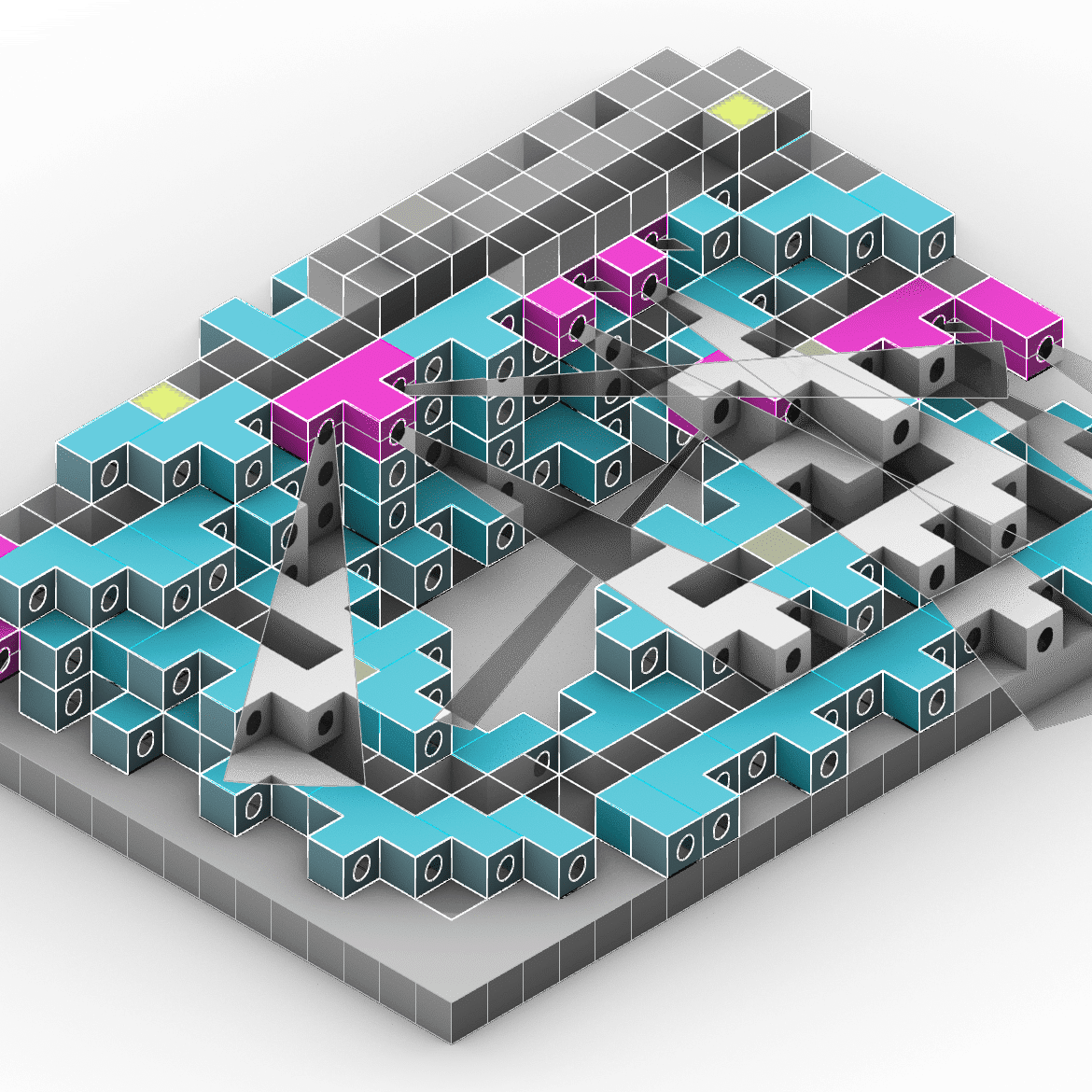
DEMO A SNAPSHOT OF THE PROJECT:
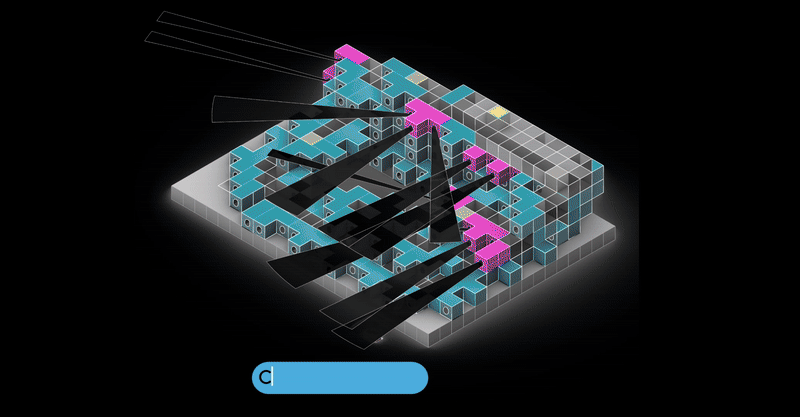
INTRODUCTION: FUNDAMENTAL
Meet John, an experienced architect working late in his studio, surrounded by sketches, coffee cups, and the familiar glow of his computer screen. He’s facing a challenge that keeps countless architects awake at night – designing a facade that’s both beautiful and performant. This is John’s story, but it’s also the story of thousands of designers worldwide who find themselves trapped in an impossible choice. John has been tasked with designing a facade for a new residential building. His client wants something “stunning and modern,” while the building codes demand specific energy performance targets. His engineering consultants are pushing for maximum insulation and minimal glazing to reduce energy consumption, while his client dreams of floor-to-ceiling windows and dramatic aesthetic appeal. John finds himself caught in the middle, forced to choose between Building Performance and Aesthetic Intent – a choice that no designer should have to make.
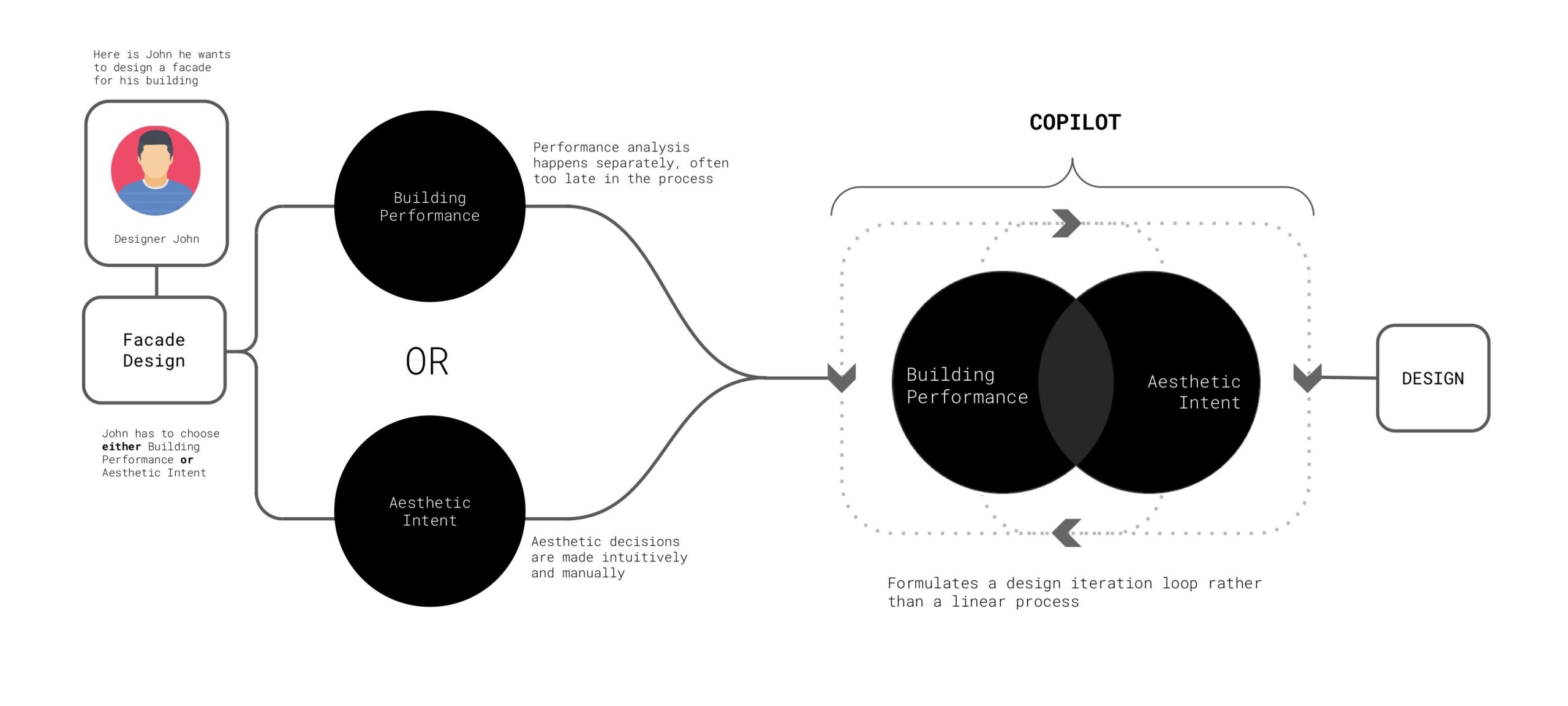
This is where John’s frustration begins. Aesthetic decisions are made intuitively and manually – he sketches beautiful proportions based on his architectural training, classical precedents, and creative vision. These decisions feel right aesthetically, they align with his client’s desires, and they create the kind of architecture that inspires people. But there’s a problem: John has no immediate way of knowing how these aesthetic choices will impact the building’s environmental performance. Will his elegant window proportions create glare problems? He simply doesn’t know at this crucial design stage. The traditional process forces John into a linear workflow where performance analysis happens separately, often too late in the process. First, he develops his facade design based on aesthetic considerations, client preferences, and architectural intuition. The facade looks beautiful in his renderings, and everyone is excited about the design direction. Only later, sometimes weeks or months into the project, does the environmental consultant run energy simulations and daylight analysis. That’s when John discovers the harsh reality: his beautiful facade is a disaster.
John faces three equally unpalatable options. He can abandon his aesthetic vision and redesign the facade around pure performance optimization, creating an efficient but uninspiring building. He can maintain his aesthetic vision and accept poor building performance, knowing that future occupants will suffer from comfort problems and high energy bills. Or he can attempt to find a compromise that satisfies neither aesthetic nor performance goals completely, resulting in a mediocre solution that pleases no one. This impossible choice represents more than just John’s personal frustration – it reveals a fundamental flaw in how our industry approaches facade design. The current paradigm treats aesthetics and performance as competing priorities rather than complementary aspects of good design. John has to choose either Building Performance or Aesthetic Intent because our traditional tools and workflows don’t support integrated optimization.
But what if John didn’t have to make this choice?
This is exactly the vision that drove us to develop ClimaSkin Copilot. Our system formulates a design iteration loop rather than a linear process, fundamentally changing how John – and designers like him – approach facade design. Instead of forcing a choice between performance and aesthetics, ClimaSkin Copilot enables a collaborative process where both criteria inform and enhance each other.
Imagine John starting his next project with ClimaSkin Copilot. As he sketches his initial facade concepts, the system provides immediate feedback about their performance implications. When he adjusts window proportions, he instantly sees how these changes affect daylight distribution, energy consumption, and visual comfort. When he experiments with shading devices, he immediately understands their impact on both solar control and architectural character. John’s creative process becomes informed by performance data, while performance optimization is guided by aesthetic goals. This paradigm shift represents more than just technological advancement – it’s a fundamental reimagining of the design process itself. ClimaSkin Copilot recognizes that the best facade designs emerge from the synthesis of performance data and creative vision, not from forcing designers to choose between them. By providing real-time performance feedback during the creative process, John can make aesthetic decisions that enhance rather than compromise building performance.
WHY SHOULD WE CARE ABOUT THIS ISSUE?
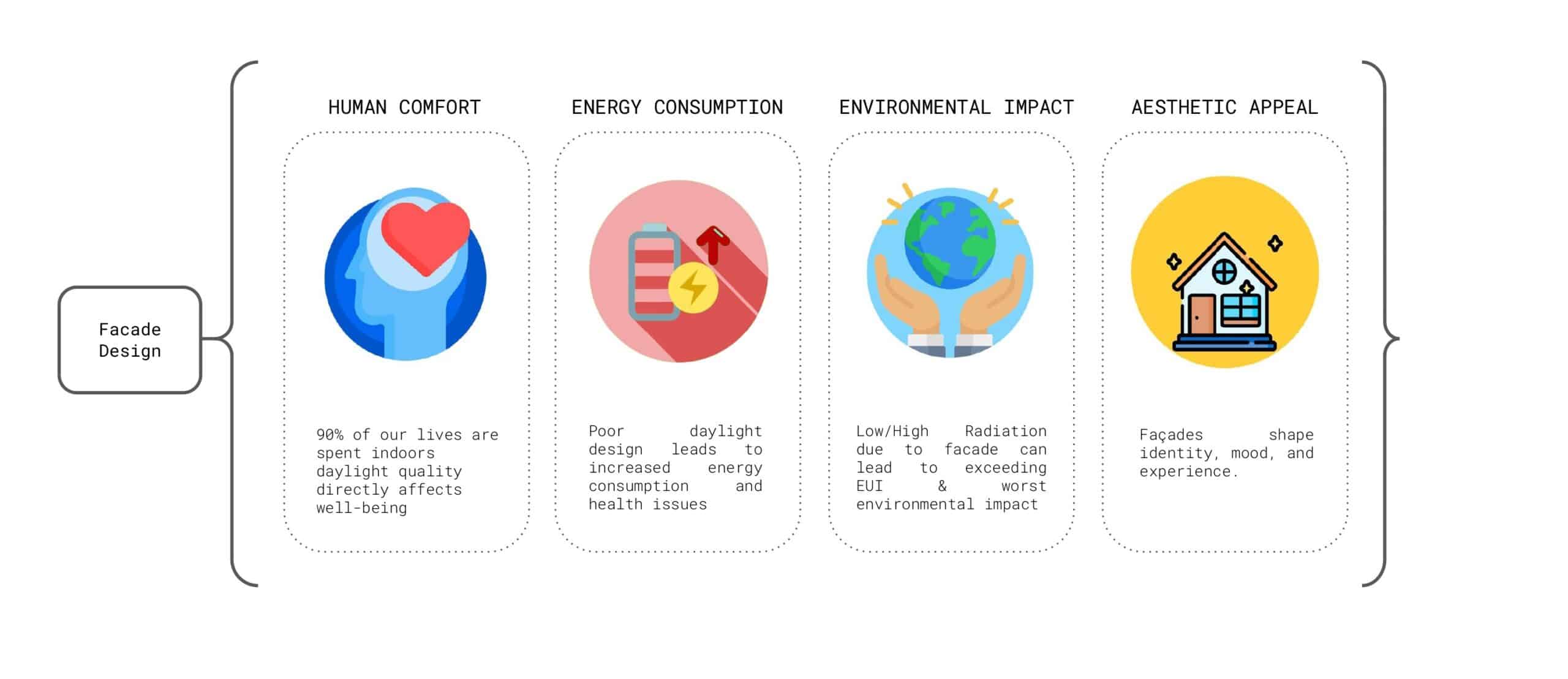
The significance of facade design extends far beyond architectural aesthetics, fundamentally impacting human well-being, global energy consumption, and environmental sustainability. Understanding these interconnected impacts is crucial for appreciating why intelligent facade design tools like ClimaSkin Copilot are not merely convenient, but essential for responsible architecture. Building energy consumption represents one of the largest opportunities for global carbon reduction and cost savings. Low/High Radiation due to facade design can lead to exceeding EUI (Energy Use Intensity), creating buildings that consume dramatically more energy than necessary for heating, cooling, and lighting. Poor facade performance contributes to worst environmental impact through increased energy consumption, but the effects extend beyond direct energy use. Buildings with excessive energy consumption contribute disproportionately to grid demand, often requiring electricity from less efficient and higher-carbon sources during peak demand periods.
The ClimaSkin Copilot recognizes these interconnected impacts by providing tools that optimize facade performance across multiple criteria simultaneously. Rather than treating energy, comfort, and aesthetics as competing priorities, our system reveals opportunities for synergistic solutions that enhance all three simultaneously.
PROJECT OVERVIEW – USER CENTRIC DESIGN
ClimaSkin Copilot transforms the traditionally complex and fragmented facade design process into an intuitive, user-friendly workflow that seamlessly integrates performance analysis with creative decision-making. Our system’s four-step process represents years of research into optimal human-computer interaction for design applications, ensuring that advanced computational capabilities remain accessible to designers regardless of their technical background.
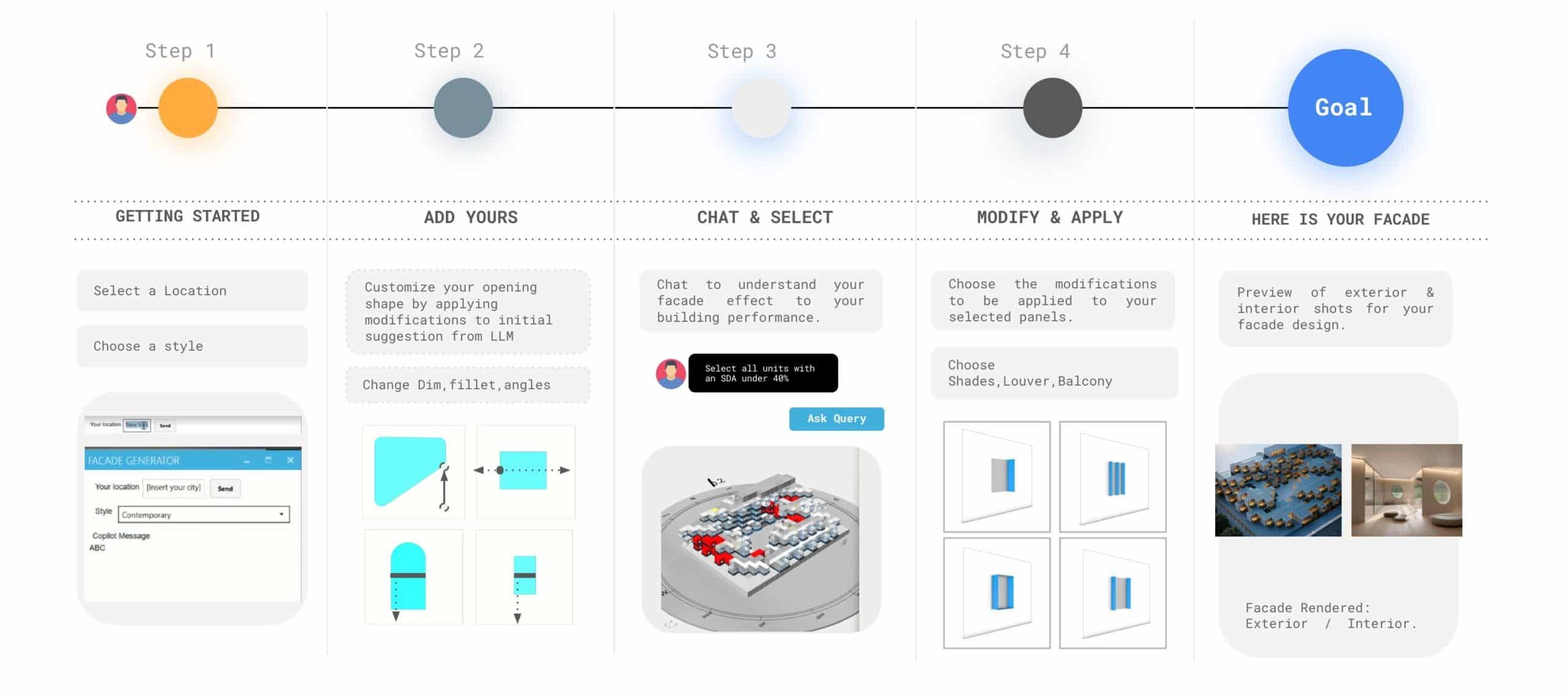
Step 1: Getting Started – Select a Location
The design process begins with location selection, which serves as the foundation for all subsequent analysis and recommendations. This seemingly simple step triggers our sophisticated RAG (Retrieval-Augmented Generation) system, which provides location-specific design parameters based on climate data, building codes, cultural preferences, and environmental conditions specific to the selected region. The RAG system accesses comprehensive databases of climatic data, solar angles, prevailing winds, temperature ranges, humidity levels, and precipitation patterns. This information is then processed through machine learning algorithms that have been trained on thousands of successful facade designs in similar climatic conditions, enabling the system to provide intelligent recommendations that are both technically sound and culturally appropriate.
Step 2: Chat & Select – Choose a Style
The style selection process represents one of ClimaSkin Copilot’s most innovative features, seamlessly blending aesthetic preferences with performance requirements. Users can choose from various architectural styles while our LLM (Large Language Model) provides intelligent suggestions based on location-specific requirements and performance optimization opportunities.
This step recognizes that architectural style is not merely decorative – different stylistic approaches have inherent performance characteristics that must be understood and optimized.
Step 3: Modify & Apply – Change Dimensions, Fillet, Angles
The modification phase provides unprecedented flexibility for customization of opening shapes by applying modifications to initial suggestions from the LLM. This step recognizes that successful facade design requires fine-tuning and adaptation that goes beyond generic recommendations. Users can adjust window dimensions, modify glazing ratios, alter shading devices, and experiment with various geometric configurations while receiving real-time feedback about performance implications. The system’s parametric modeling capabilities ensure that all modifications are automatically evaluated for their impact on daylight, energy consumption, and visual comfort.
Step 4: Add Yours – Ask Query
The query phase represents the culmination of the design process, where users can chat to understand their facade effect on building performance through sophisticated natural language processing. This conversational interface allows designers to ask complex questions about their facade’s performance and receive actionable insights and recommendations. Users can explore various enhancement options including shades, louvers, and balconies, with the system providing comprehensive analysis of how each modification will impact overall building performance.
COMPLETE WORKFLOW: THE TECHNICAL ARCHITECTURE
The ClimaSkin Copilot operates through a sophisticated backend architecture that seamlessly integrates multiple advanced technologies into a coherent design support system. Understanding this technical architecture is crucial for appreciating how the system delivers its powerful capabilities while maintaining user-friendly operation. At the foundation of our system lies a comprehensive dictionary of building components that provides the parametric foundation for all design variations. This component library includes detailed specifications for windows, doors, shading devices, structural elements, and material properties, each with associated performance characteristics and compatibility requirements.
Components and Representation System: At the foundation of our system lies a comprehensive dictionary of building components that provides the parametric foundation for all design variations. This component library includes detailed specifications for windows, doors, shading devices, structural elements, and material properties, each with associated performance characteristics and compatibility requirements. The updated BDG (Building Design Grammar) with initial style includes panel indices based on orientations, ensuring that all facade elements are properly classified and analyzed according to their solar exposure, wind patterns, and view characteristics. This systematic approach enables the consistent application of performance analysis across complex building geometries while maintaining design flexibility. The component system is designed for extensibility, allowing users to define custom components or import manufacturer-specific product data. This flexibility ensures that the system can accommodate the latest building technologies and materials while maintaining compatibility with established construction practices.
Advanced Query Processing System:
- Type 1: Unit-Based Filtering processes requests to filter units based on properties such as low sDA (Spatial Daylight Autonomy), WWR (Window-to-Wall Ratio), and high radiation levels. These queries return unit IDs that can be used for targeted design interventions, enabling designers to focus their attention on areas with the greatest optimization potential.
- Type 2: Panel-Based Analysis handles more granular requests to filter panels based on criteria including room connections, orientation, daylight performance, and thermal characteristics. These queries return both unit IDs and panel IDs, providing the precision necessary for detailed facade optimization strategies.
- Type 3: Analytical Summaries generate table summary counts based on performance properties or intelligent insights generated by the LLM. These queries return comprehensive text descriptions that help designers understand overall building performance patterns and identify optimization opportunities.
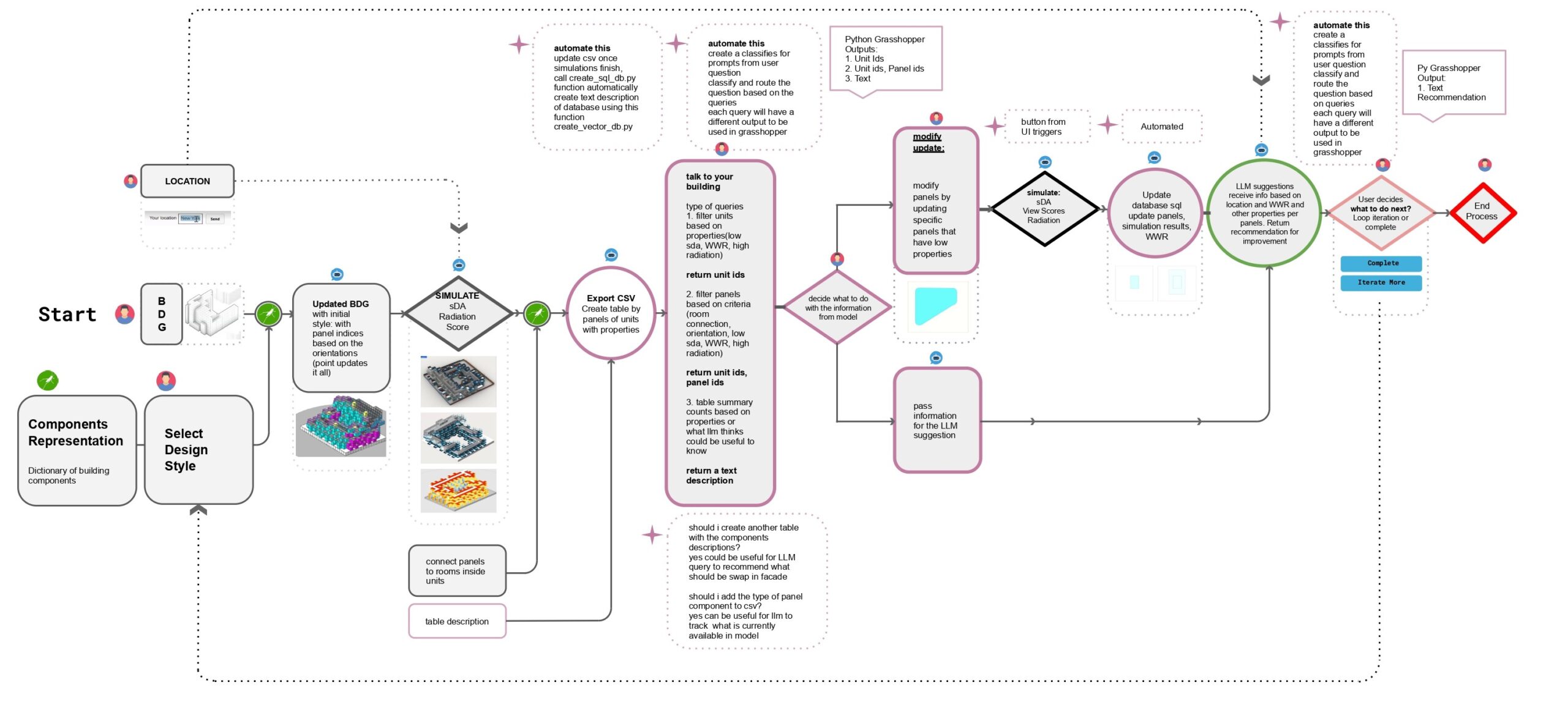
PROJECT OVERVIEW | SNAPSHOT
The ClimaSkin Copilot integrates multiple advanced technologies into a seamless design pipeline that spans from initial concept development through final visualization. This integration represents a significant technological achievement, bringing together traditionally separate tools and workflows into a coherent system that supports the complete facade design process.
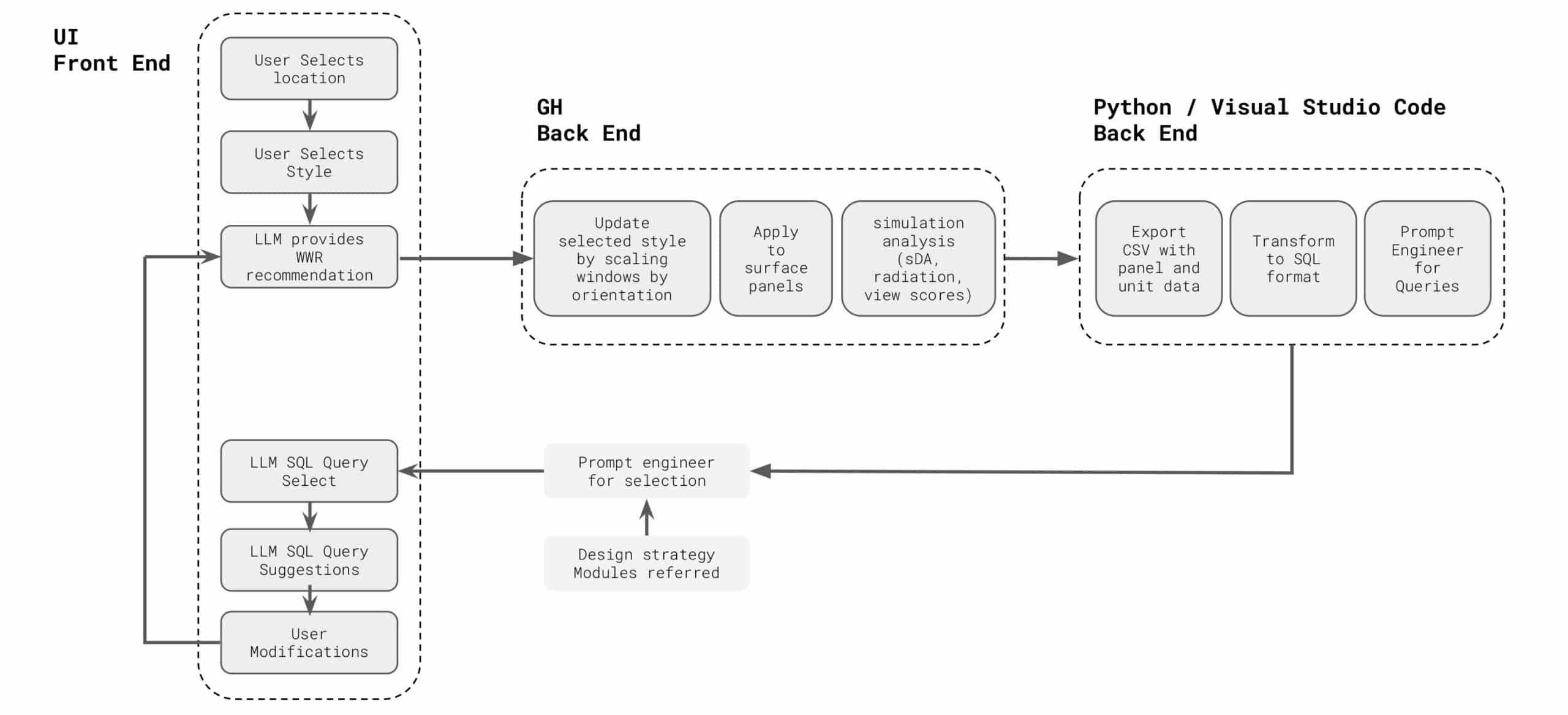
Frontend Interface (UI) The user interface represents the visible face of ClimaSkin Copilot, designed according to principles of human-centered design to ensure accessibility for designers with varying levels of technical expertise. The interface provides intuitive tools for location and style selection, enabling users to quickly establish the foundational parameters for their facade design. Real-time visualization capabilities allow designers to see the immediate impact of their decisions, providing instant feedback that supports iterative design development. Interactive modification tools enable precise control over facade elements while maintaining connection to underlying performance analysis. The interface design prioritizes visual clarity and workflow efficiency, recognizing that facade design is inherently visual and requires tools that support both analytical thinking and creative exploration. Advanced data visualization techniques help designers understand complex performance relationships through intuitive graphics and interactive displays.
Backend Processing (Grasshopper): The Grasshopper backend provides the parametric modeling foundation that enables ClimaSkin Copilot’s advanced analytical capabilities. LLM-provided WWR recommendations are automatically integrated into the parametric model based on comprehensive location data, ensuring that initial design proposals are grounded in climate-appropriate strategies. The system updates selected styles by scaling windows by orientation, recognizing that optimal facade design requires different approaches for different solar exposures. South-facing facades require different strategies than north-facing ones, and the system automatically adjusts design recommendations accordingly. Application of modifications to surface panels is handled through sophisticated parametric algorithms that maintain design coherence while enabling creative exploration. This capability ensures that user modifications are automatically propagated throughout the design while maintaining performance optimization.
Backend Processing (Python/Visual Studio Code) The Python backend handles the computationally intensive aspects of facade analysis, including simulation analysis for sDA, radiation, and view scores. These calculations require significant computational resources and specialized algorithms that are optimized for building performance analysis. CSV export with panel and unit data enables integration with other design tools and analysis workflows, ensuring that ClimaSkin Copilot can function as part of larger design ecosystems rather than as an isolated tool. SQL format transformation enables efficient data querying and analysis, while prompt engineering for queries ensures that natural language interactions are accurately translated into computational operations.
Step-by-Step Process Deep Dive
Step 1: Location and RAG Retrievals – The Foundation of Climate-Responsive Design
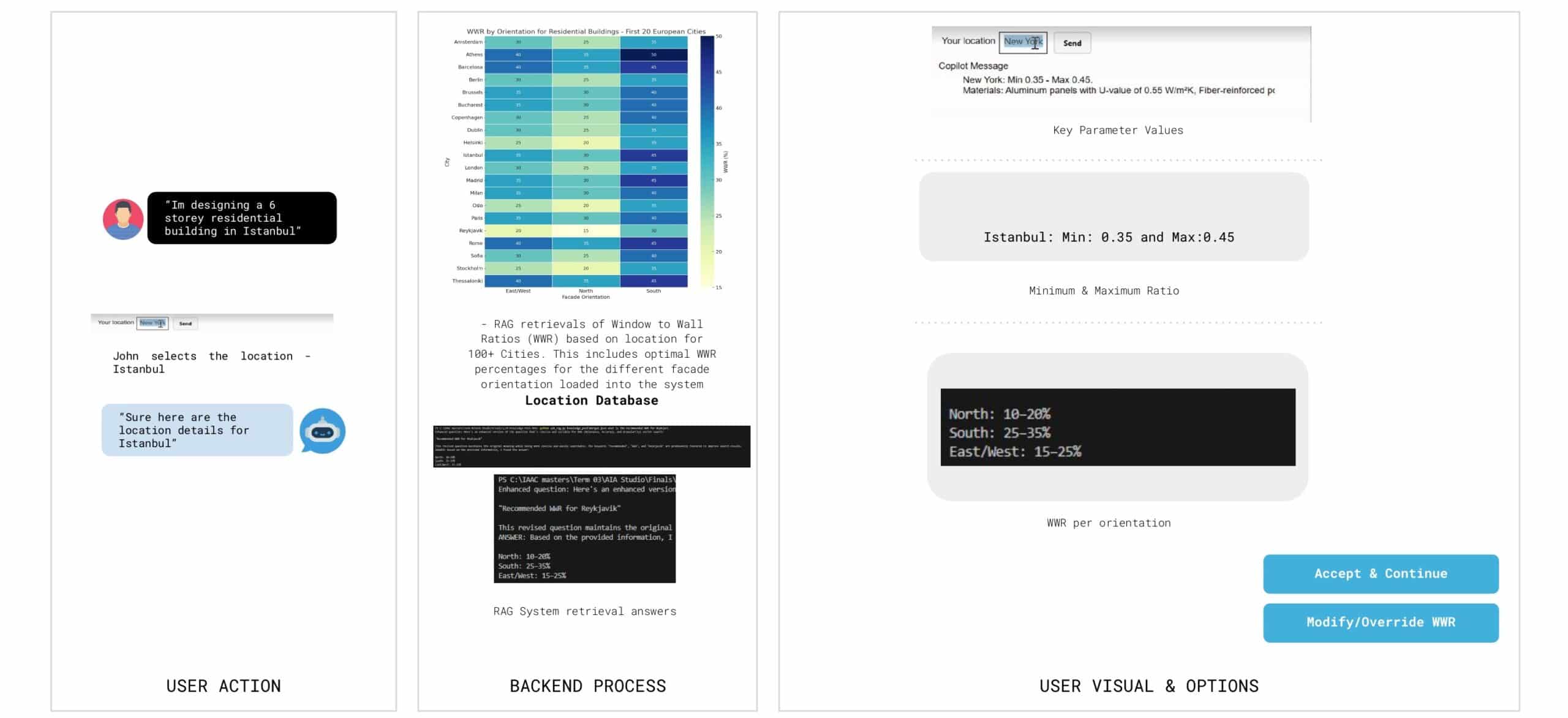
When a user initiates the design process by stating: “I’m designing a 6 storey residential building in Istanbul”, they trigger one of ClimaSkin Copilot’s most sophisticated subsystems: the location-based RAG (Retrieval-Augmented Generation) system that provides comprehensive climate-responsive design guidance. The system’s response begins with comprehensive location data that extends far beyond simple geographic coordinates. RAG retrievals of Window to Wall Ratios (WWR) are performed based on location data for over 100 cities worldwide, each with detailed climate analysis and performance optimization data collected from successful building projects in similar conditions.
This database includes optimal WWR percentages for different facade orientations that have been validated through both computational analysis and post-occupancy evaluations of real buildings. The system understands that optimal WWR varies not just by climate, but by orientation, building use, occupant preferences, and local building codes. The Location Database RAG System provides key parameter values that serve as intelligent starting points for design development. For Istanbul specifically, the system recommends minimum WWR of 0.35 and maximum WWR of 0.45, with orientation-specific variations that account for the city’s specific solar angles, seasonal weather patterns, and cultural preferences for natural light. Users retain complete design control through options to modify/override WWR recommendations or accept & continue with system suggestions. This flexibility ensures that the system supports rather than constrains creative decision-making while providing valuable technical guidance.
Step 2: Design Style Integration – Bridging Aesthetics and Performance
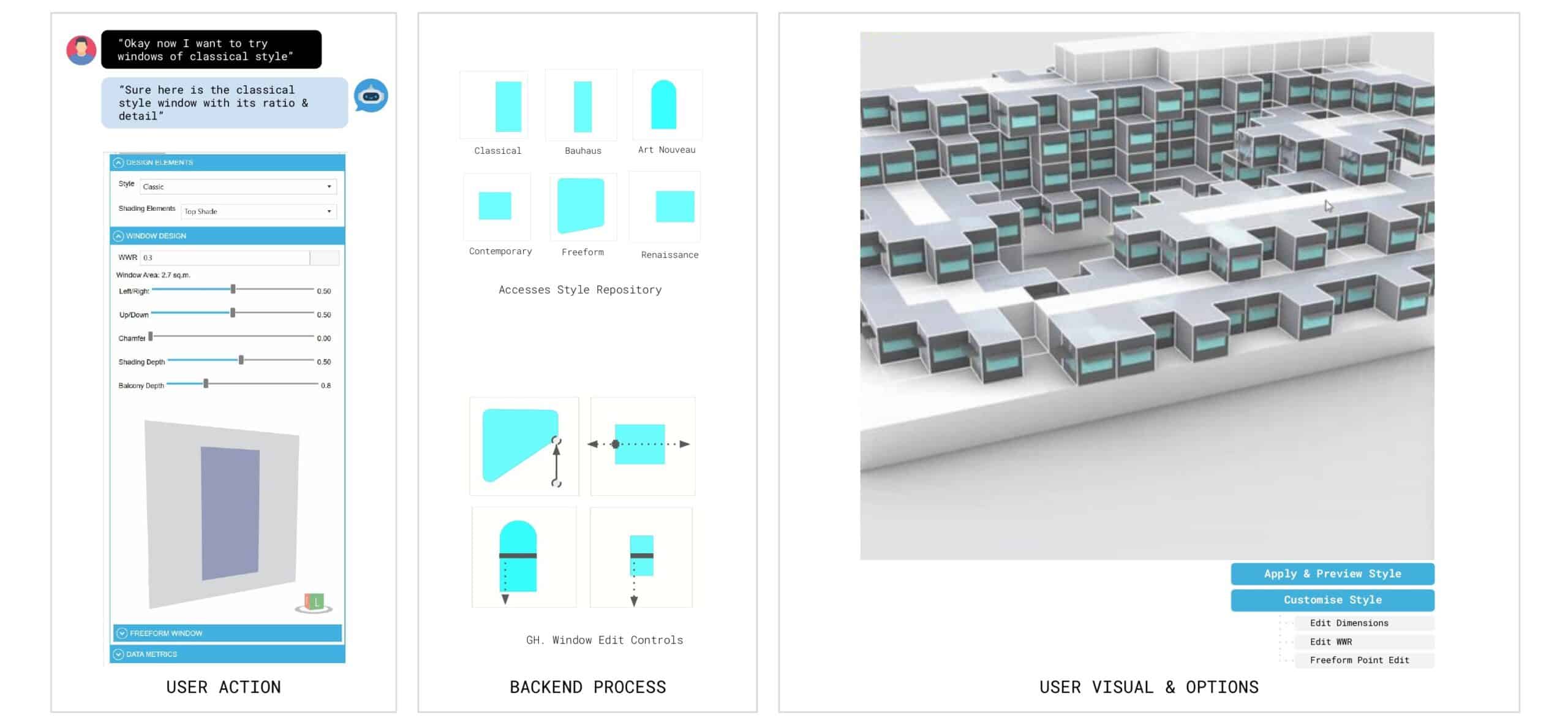
The style selection process represents one of ClimaSkin Copilot’s most innovative achievements: the seamless integration of aesthetic preferences with quantitative performance analysis. When users request: “Okay now I want to try windows of classical style”, they initiate a sophisticated process that marries historical architectural wisdom with contemporary building science. The system accesses a comprehensive Style Repository that includes detailed analysis of six major architectural approaches: Classical, Bauhaus, Art Nouveau, Renaissance, Freeform, and Contemporary. Each style category includes not just visual characteristics, but comprehensive performance data about how these aesthetic approaches typically influence building environmental performance. Classical facades, for example, traditionally incorporate deep reveals, substantial masonry mass, and proportional systems that create inherent solar control and thermal mass benefits. The system understands these performance characteristics and can predict how classical proportions will influence daylight distribution, thermal comfort, and energy consumption in the specific climate context.
The application and preview system provides immediate visual feedback showing how the selected style appears when applied to the user’s specific building geometry and location. This preview includes appropriate ratios and architectural details that are both historically accurate and performance-optimized for the local climate. Customization options provide unprecedented flexibility while maintaining style coherence. Users can edit dimensions to adjust proportions for specific functional requirements, modify WWR to optimize daylight or energy performance, and use freeform point editing for precise control over facade geometry. The Grasshopper Window Edit Controls integration ensures that all modifications are automatically evaluated for their performance implications while maintaining compatibility with the overall building information model. This integration enables real-time optimization that would be impossible with traditional design tools.
Step 3: Simulation Database Creation – Quantifying Performance
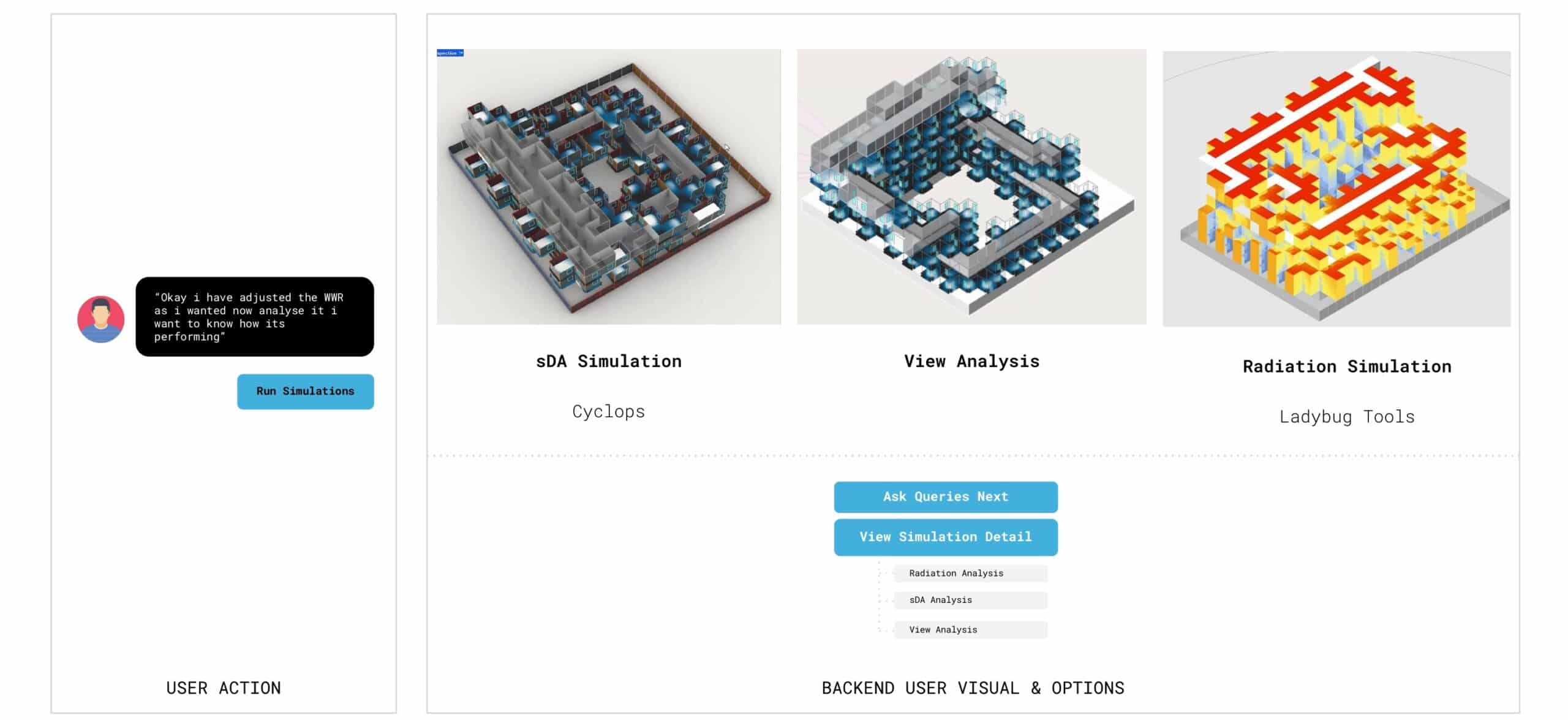
Following the user’s request: “Okay I have adjusted the WWR as I wanted now analyze it I want to know how it’s performing”, ClimaSkin Copilot initiates its comprehensive simulation engine that provides quantitative analysis across multiple performance criteria.
- sDA Simulation using Cyclops provides detailed daylight analysis that goes far beyond simple illumination calculations. The Spatial Daylight Autonomy metric quantifies what percentage of each space receives adequate natural light (typically 300 lux) for at least 50% of occupied hours throughout the year. This analysis directly correlates with occupant satisfaction, energy savings from reduced artificial lighting, and compliance with green building standards like LEED and BREEAM.
- View Analysis evaluates the quality of exterior views from interior spaces, considering factors such as sky visibility, landscape features, and urban context. This analysis recognizes that connection to the outdoors is crucial for occupant well-being and can significantly influence real estate values and tenant satisfaction.
- Radiation Simulation using Ladybug Tools provides comprehensive thermal analysis that evaluates solar heat gain, surface temperatures, and thermal comfort implications. This analysis is crucial for predicting energy consumption, identifying overheating risks, and optimizing facade design for year-round comfort.
The simulation results are compiled into comprehensive simulation details that include radiation analysis showing heat gain patterns throughout the year, sDA analysis indicating daylight quality in all spaces, and view analysis quantifying connection to the outdoors. These results are presented through intuitive visualizations that help designers understand complex performance relationships and identify optimization opportunities.
Step 4A: SQL Query and Graph Communication – Structured Data Analysis
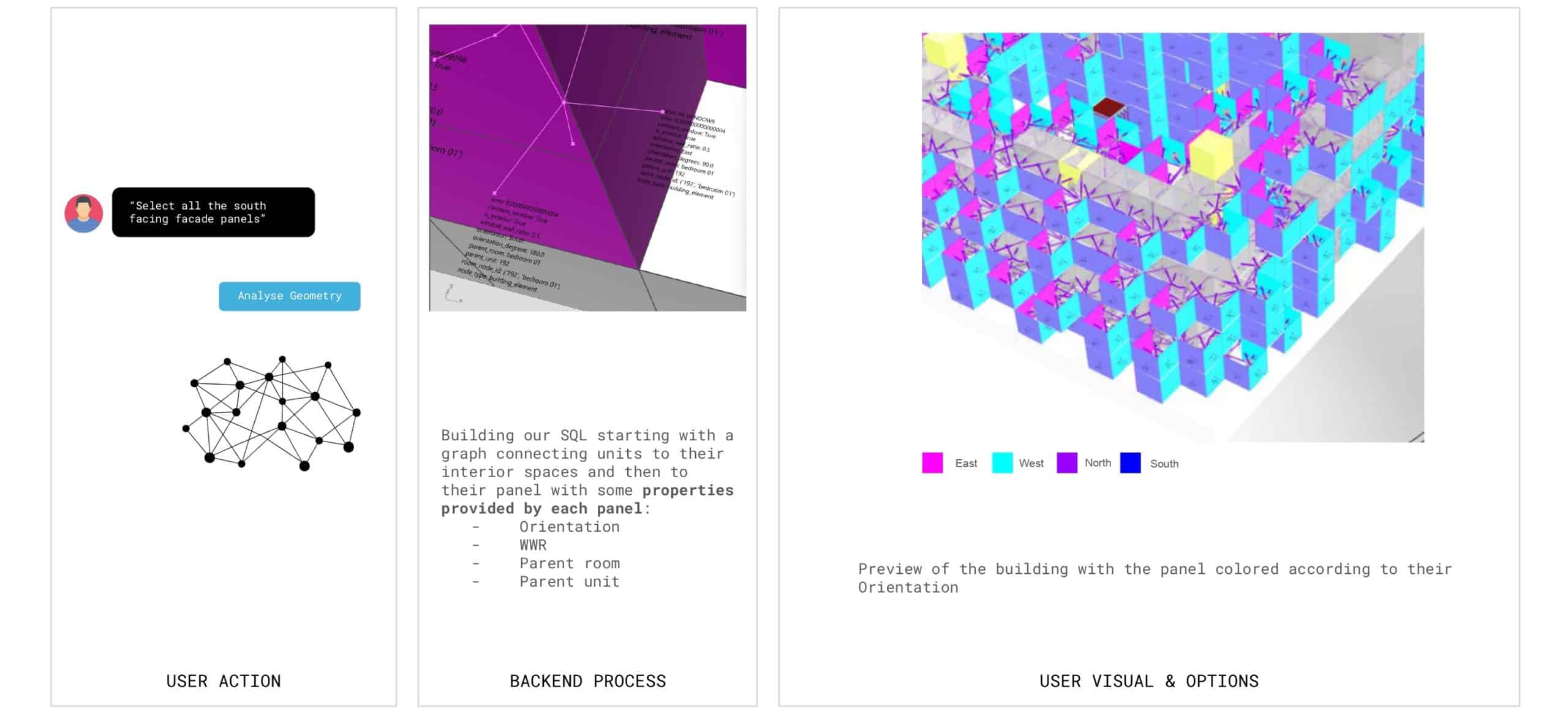
The transition from simulation to actionable design guidance occurs through ClimaSkin Copilot’s sophisticated data management system that builds SQL databases starting with graphs connecting units to their interior spaces and then to individual facade panels with comprehensive property data. The system maintains detailed information about each facade panel including orientation (East, West, North, South), WWR, parent room relationships, and parent unit connections. This structured approach enables precise queries that can identify specific areas of concern or opportunity within complex building designs.
When users query the system with requests like: “Select all the south facing facade panels”, they receive immediate visual feedback through preview of the building with panels colored according to their orientation. This visualization capability helps designers understand their building’s performance patterns and identify areas that may benefit from targeted design interventions.The graph-based data structure enables complex relational queries that would be impossible with simpler data management approaches. Designers can explore relationships between interior spaces and facade performance, identify patterns across similar spaces, and develop targeted strategies for different building zones.
Step 4B: Advanced Query Processing – Targeted Analysis
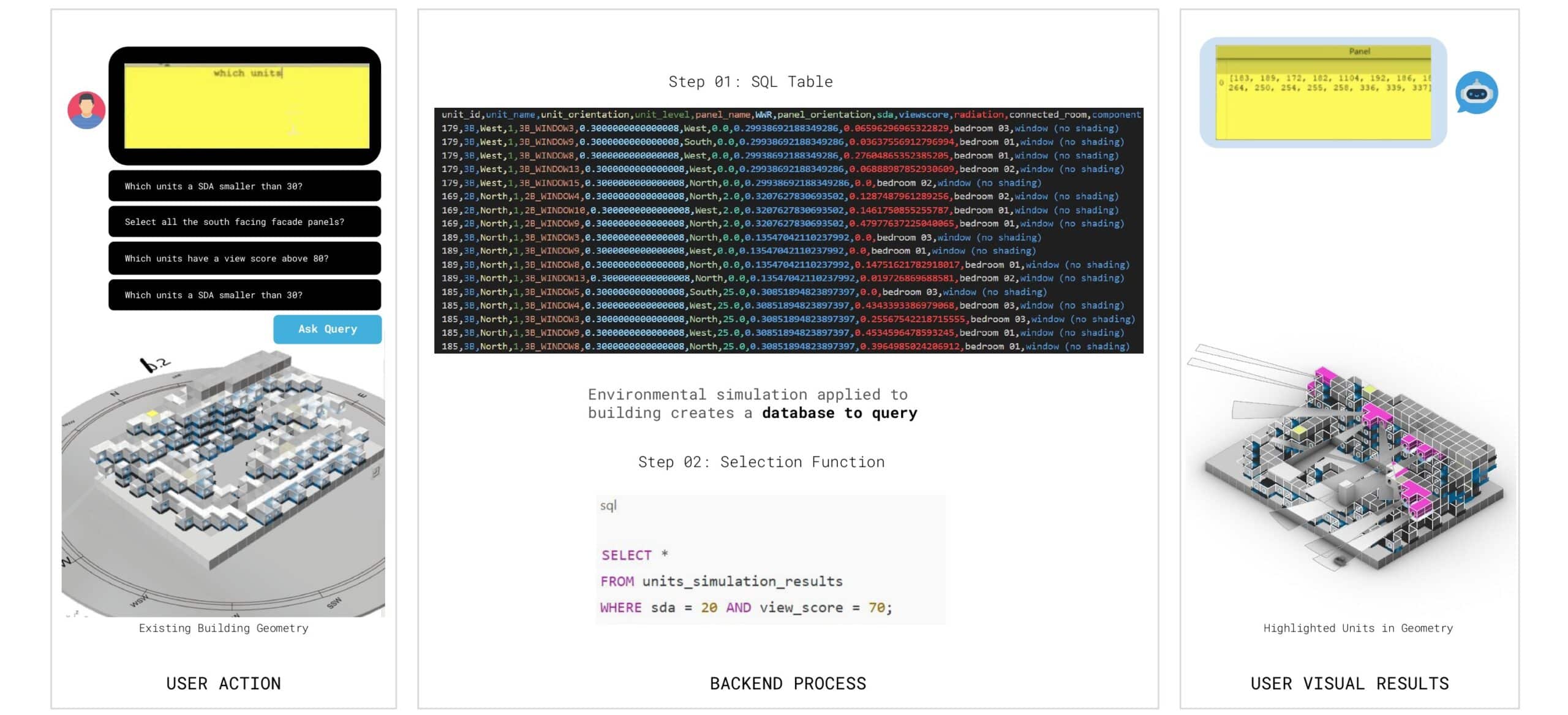
The advanced query processing system enables designers to ask sophisticated questions about their building’s performance and receive precise, actionable answers. Environmental simulation applied to building creates a database to query with examples including:
- “Which units have SDA smaller than 30?” – identifying spaces with inadequate daylight that may require facade modifications or supplemental lighting
- “Select all the south facing facade panels?” – enabling targeted solar control strategies for high-exposure orientations
- “Which units have a view score above 80?” – identifying spaces with exceptional exterior connections that should be preserved or enhanced
The system provides highlighted units in geometry alongside existing building geometry through a sophisticated two-step process. SQL Table creation organizes all performance data into queryable formats, while Selection Function execution translates user queries into visual highlighting that helps designers understand spatial relationships and performance patterns. This capability enables designers to move beyond general optimization strategies to develop targeted interventions that address specific performance challenges while preserving areas that are already performing well.
Step 5: LLM-Powered Design Suggestions – Intelligent Optimization
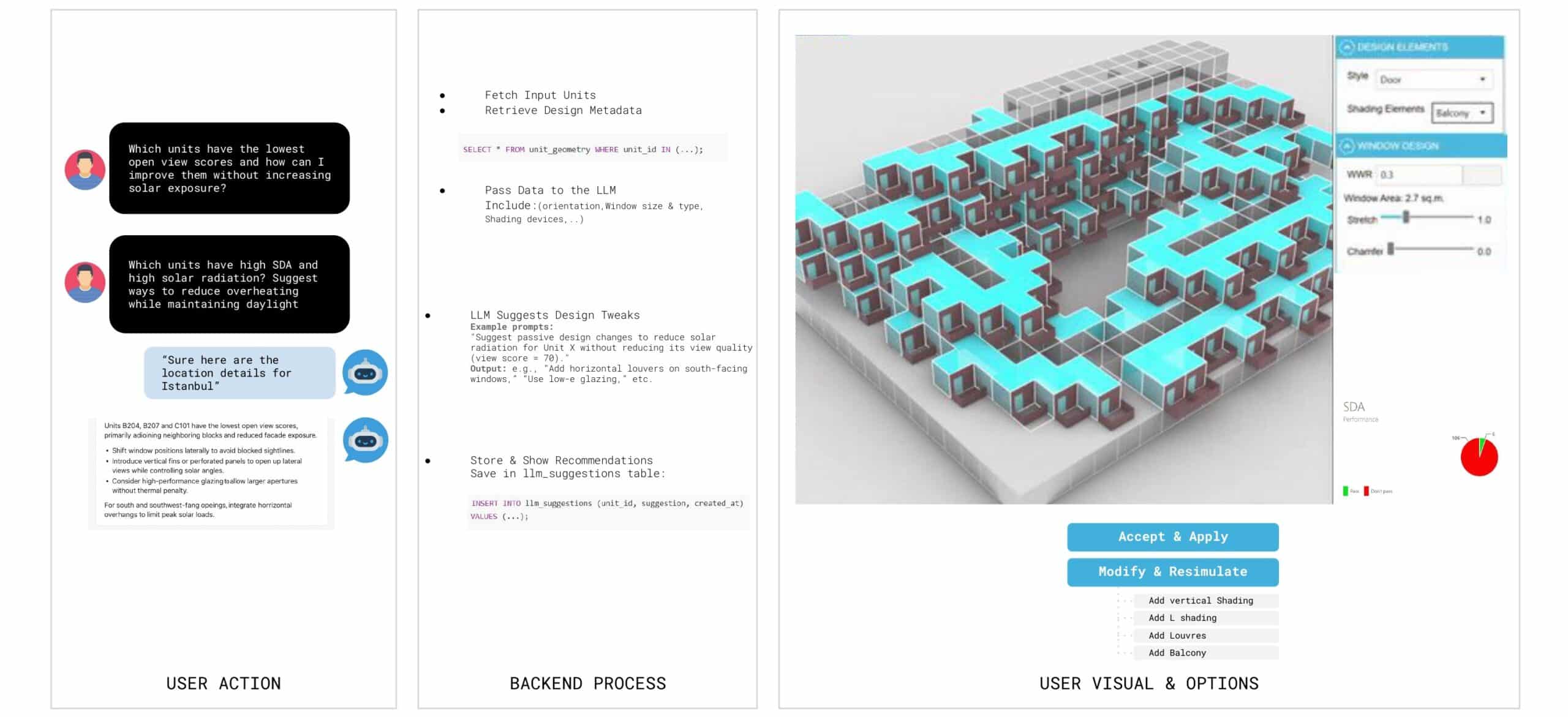
The LLM suggestion system represents the culmination of ClimaSkin Copilot’s artificial intelligence capabilities, providing contextually appropriate design recommendations that consider the complex interactions between multiple performance criteria. When users pose complex questions like: “Which units have the lowest open view scores and how can I improve them without increasing solar exposure?” or “Which units have high SDA and high solar radiation? Suggest ways to reduce overheating while maintaining daylight”, they engage with one of the most sophisticated AI systems ever developed for architectural design. The system’s analytical process begins by fetching input units and retrieving comprehensive design metadata including orientation, window size and type, existing shading devices, material properties, and surrounding context. This data compilation ensures that recommendations are based on complete understanding of existing conditions and design constraints. Data is passed to the LLM along with specific prompts that guide the AI toward contextually appropriate recommendations. Example prompts include: “Suggest passive design changes to reduce solar radiation for Unit X without reducing its view quality (view score = 70).” These carefully crafted prompts ensure that the AI considers multiple performance criteria simultaneously and provides recommendations that enhance overall building performance.
LLM-generated design suggestions are stored in comprehensive databases that track recommendation effectiveness and enable continuous system improvement. The AI can suggest various interventions including:
- Add vertical shading for precise solar control without view obstruction
- Add L-shaped shading for corner conditions requiring multi-directional solar control
- Add louvers for adjustable solar control that can respond to seasonal variations
- Add balconies for integrated shading, outdoor space, and architectural character
Step 6: Final Step: Advanced Visualization – Bringing Designs to Life
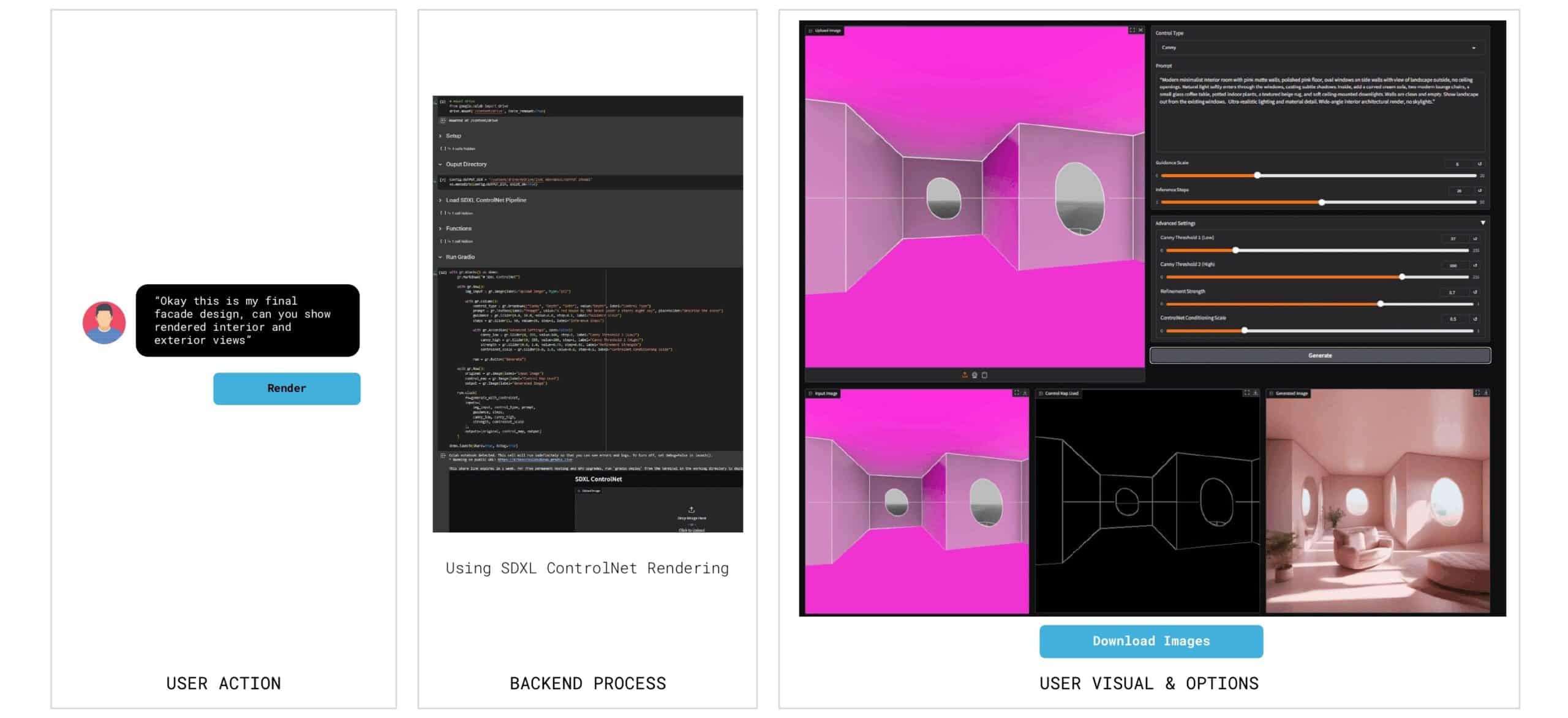
The visualization phase transforms technical analysis into compelling visual representations that help designers communicate their ideas and evaluate aesthetic success. When users request: “Okay this is my final facade design, can you show rendered interior and exterior views”, they access ClimaSkin Copilot’s advanced SDXL ControlNet Rendering system. This cutting-edge rendering technology produces photorealistic visualizations that accurately represent both the aesthetic qualities and performance characteristics of the proposed facade design. The system generates both interior and exterior views that help designers evaluate their success in balancing performance optimization with aesthetic goals.
High-quality rendered visualizations include accurate representation of material properties, lighting conditions, and environmental context. Both interior and exterior views enable comprehensive evaluation of how the facade performs from multiple perspectives, while downloadable images ensure that results can be easily integrated into presentations and design documentation.
CONTROLNET | RENDERS
Interior shots:
CONCLUSION:
Looking toward the future, ClimaSkin Copilot represents a model for how artificial intelligence can augment human creativity rather than replace it. The system provides designers with unprecedented analytical capabilities while preserving the creative decision-making that defines architectural excellence. This human-AI collaboration model suggests new possibilities for addressing complex design challenges across multiple scales and building types.
As we move toward a more sustainable and equitable built environment, tools like ClimaSkin Copilot become essential infrastructure for creating architecture that truly serves both people and planet. The project demonstrates that high-performance building design and architectural excellence are not competing goals, but complementary aspects of responsible design practice.
ClimaSkin Copilot represents more than a technological achievement – it embodies a fundamental paradigm shift in how we approach facade design in the 21st century. By moving from the traditional either/or approach that forces designers to choose between building performance and aesthetic intent, our system enables a comprehensive both/and methodology that optimizes multiple criteria simultaneously.
The integration of AI-powered location-specific recommendations ensures that every design begins with climate-appropriate strategies, while real-time performance simulation provides continuous feedback that supports informed decision-making throughout the design process. Intelligent design suggestions help designers discover optimization opportunities they might not have considered, while advanced visualization capabilities ensure that technical optimization doesn’t come at the expense of aesthetic quality. The system’s impact extends beyond individual building projects to influence the broader architectural profession. By democratizing access to advanced building science knowledge, ClimaSkin Copilot enables designers of all experience levels to create high-performance buildings. This capability is particularly important as the profession faces increasing pressure to address climate change while maintaining the aesthetic and cultural values that make architecture meaningful.

